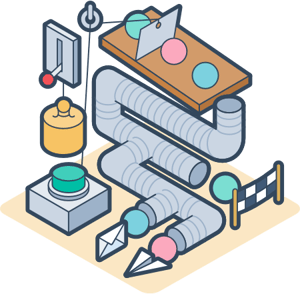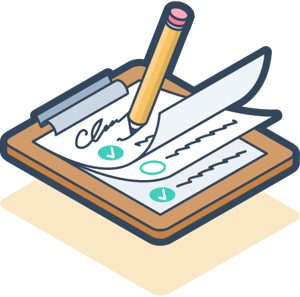Consistency and quality are central to a good user experience. But despite your — or your product team’s — best intentions, inconsistencies and unintended consequences will inevitably crop up. And if you're not careful, you'll end up with a poor user experience and a lot of design debt. We all know it takes a lot longer to dig yourself out of debt than it does to avoid it in the first place, so we try to avoid design debt from the start by explicitly including design review and design QA in our process.
Design Debt affects the integrity of the user experience. This is what happens when a bunch of incremental changes collect over time and yield a disjointed, inconsistent, and patched-together experience.
— Austin Knight, Design Debt
By incorporating design review and QA into our process, we’re able to check and recheck that we’re staying on track and delivering on the original intent of the experience.
But what do we mean by those different terms?
Design review is what we do at regular intervals during the design process.
Design QA is the final, more rigorous check.
 We approach the whole process as a team sport. Everyone’s role — research, design, content, engineering — affects the customer experience. So we run design review and QA on individual issues on GitHub, so everyone can participate in the conversation in a centralized place. This is also a great practice for distributed teams, since the conversation can be asynchronous, and anyone can join in, get caught up, and explore the full context on their own time.
We approach the whole process as a team sport. Everyone’s role — research, design, content, engineering — affects the customer experience. So we run design review and QA on individual issues on GitHub, so everyone can participate in the conversation in a centralized place. This is also a great practice for distributed teams, since the conversation can be asynchronous, and anyone can join in, get caught up, and explore the full context on their own time.
Design Process Guidelines
The process that leads up to the final design QA step is as important as the last stage itself. Because if you’re collaborative and communicative throughout the whole process, the final QA piece can be a relative breeze.
Here are the guidelines we try to follow throughout the whole design and development process.
Design is a conversation
Good design is a conversation, not a series of episodes of individual work. Just as it's best for designers to show their ideas to engineers early in review meetings, it's better for engineers to show designers their work early, too. We encourage engineers to share their work with their designer in GitHub long before it’s ready to ship.
If there are inconsistencies between design and what has been coded , the designer can easily chat with the engineer to explore how to address it.
Design is a process, not an event
Each development process involves several touchpoints during which a design can be evaluated for adherence to intent and consistency with Canvas, the HubSpot Design System. Each of these touchpoints offers a chance for the engineer and designer to check in with each other and make sure everything’s going according to plan.
So before anything gets passed into the next stage of the process — whether it’s just a review or into production — a designer gets called in to take a look at what’s there. This responsibility goes both ways, of course. Engineers are asked to take that moment to get a designer to review something, so designers need to make themselves available when called. Nobody’s expected to drop everything, of course. But a response within a reasonable amount of time is necessary to keep things moving, and to maintain a tightly knit collaboration on a small, fast-moving team.
A shared definition of what quality means
Usually a team will define their quality acceptance criteria together, before anything gets built. Then, when specifications for the design are provided to the engineer, everyone has the same expectations for how precisely it will translate into reality.
It is the whole team’s responsibility to ensure that the software is rendered as the designer intended, which is why ongoing communication and collaboration are so important.
Design Review
So what happens at those various touch points along the way when a team gets together for a review? Basically, it’s a short presentation and feedback session of potential design issues at various levels of fidelity. And the meeting should be with a diverse group of role representatives, so that different priorities have their own voice in the room.
User desirability ‐ Usually represented by a designer
Business viability ‐ Usually represented by a product manager
Technical feasibility ‐ Usually represented by a tech lead or senior engineer
The review session is where all those important but sometimes conflicting needs are aligned and any potential tradeoffs are discussed.
The objective is to ensure that everybody comes to a high level of agreement that the design solution meets the business requirements, is technically feasible, and accurately reflects the needs of the user.
A design review isn’t a backlog or catch-up meeting. Not everyone on the team should attend. But it is important to make sure the three viewpoints above are all in the same room.
Elements of a Good Design Review
A lot has been written over the years about how to run a good design review. We don’t set out to reinvent the design review wheel, but we’ve found that adhering to the following guidelines help us make sure our design reviews are conducted, attended, and effective.
- The designer organizes the design review, making sure all the right people can come.
- Reviews are fixed events on the calendar, which tends to make it easier for everyone to attend.
- Design review meetings require three (or more) participants. It's not just for the product manager and designer to go over things alone. The technical input is fundamental.
- The first review should happen early, often at the stage when there are only sketches and user flows to review. Finished designs are also be discussed at later stages.
- The designer takes notes and records the findings from the review.
- Feedback from the design review should be incorporated into the design before the next design review meeting.
Design QA Checklist
While it may be challenging to address 100% of inconsistencies all of the time, doing Design QA is a big step towards combating design debt.
— Jess Eddy
 Here’s a sample checklist of what we’ll look for whenever we need to review a design:
Here’s a sample checklist of what we’ll look for whenever we need to review a design:
- Does this match the HubSpot Canvas guidelines?
- Check especially the colors, spacing, text styles, and content
- Interactions and behaviors
- Have we accounted for any edge cases?
- How are we handling any error states?
- Is this ready for localization and translation?
- Are all the language strings externalized?
- Is currency treated in a way that will translate?
- Are there any images or illustrations with text within them?
- Are any strings broken up by UI elements that will present difficulty when translated?
- How does a desktop feature render on a smaller screen? On a tablet?
- How will this work in different browsers?
- If this is designed for mobile, does it work on a small phone as well as on a larger phone?
- Is this design accessible?
- Are the color contrasts good for those with colorblindness?
- What about other forms of visual impairment?
- Is the text at a 7-9 grade reading level?
- Does it work when a screen reader is used?
The Final Design QA Process
Once the conversation of the design process has taken its course, and the team agrees that it’s time to see if a thing is ready to ship, it’s time for the final Design QA piece. Your process may vary depending on the tools that you use. The important thing is to establish a clear, step-by-step process that you follow each time.
- The engineer determines that the issue they’re working on is ready for Design QA. They create a staging build and move the GitHub issue to the Design QA board on the ZenHub workflow.
- The designer gets a notification from GitHub that the issue has been moved to the Design QA board and it’s been assigned to them.
- The designer goes through the design QA checklist above once more.
- If there are no bugs, the issue passes design QA and is moved to production.
- If there are bugs, the designer logs those bugs and assigns them a severity.
- If the issue is returned to the engineer, the issue remains in Development.
- If the issue is not returned to the engineer, the issue is moved to QA and the bugs raised by the designer go into a parallel "bug triage process" for later consideration.
- The Issue is now on QA and follows the overall QA process. The engineer adds a gif or recording screenshot so that the designer can check what’s being built.
- The designer gets a notification via GitHub that the issue is in production.
- The designer performs the final design QA on the live website or platform.
By following a shared process of regular review and QA, we’re able to make sure that our designs are delivering on our original intent. Not only does this allow us to deliver a great result to our users, it keeps our teams working happily and healthily together, and helps keep us from digging ourselves into a hole of design debt.
